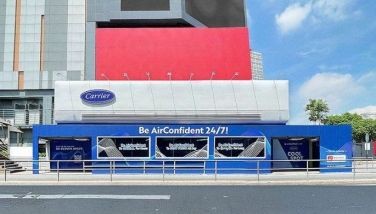Operate NAIA-3? But it’s unfinished

February 28, 2003 | 12:00am
When it comes to striking win-win solutions, Mar Roxas is perhaps the most adept in the Cabinet. He’s had a string of them: In the San Miguel-Kirin beer buy-in, the National Steel Corp. revival, and recently the railway annex to Cavite. But when the trade-and-industry secretary broached the operation of Ninoy Aquino International Airport’s contentious terminal-3, he only struck raw nerves of the clashing parties.
Piatco, the consortium that holds what government calls an onerous build-operate-transfer deal, pounced on the idea with a notice that it long ago had hired and trained hundreds of technicians for the stalled airport. Rehashing claims of contract validity, it said it can get NAIA-3 running in two months. On the other end, the lobby of airport service firms that sued Piatco for monopolism called Roxas’s proposal a legal booby trap. Letting Piatco start up the terminal would jeopardize their – and the government’s – case to have the contract voided. Just wait for the Supreme Court verdict that’s due in a few weeks anyway, they admonished.
Roxas never said he wanted Piatco, but a third party, to operate the terminal in time for the tourism department’s Visit-the-Philippines bash. "We do not intend to intrude in the resolution of issues concerning validity of contract, ownership rights, who owns what, or who financed what," he clarified. "Let the courts decide these." But the impasse needs to be broken. Noting other multibillion-peso projects now on hold pending resolution by some authority, he said: "We’ve been going around and around this issue, we must move forward."
Easier said than done, though. For, aside from the legal tie-up are construction, technical and financial knots that need untangling.
To begin with, NAIA-3 is not even finished. Takenaka Corp., the general constructor, had stopped work last Nov. because of $17 million in uncollected billings to Piatco. Controlled by the Cheng family of cargo forwarders, Piatco had dried up from a partnership feud months earlier. It turned out that Germany’s Fraport AG, although only 30-percent owner, had been plunking in most of the money since construction began in 2000. Discovering cost overruns, it stopped giving and told the Chengs to put up their share of the capital. Fraport has estimated that $37 million would be needed to complete the structure and put in the equipment.
Even if work is finished, the terminal has yet to be systems-tested for bugs. Piatco’s publicists had held a series of media and businessmen tours of the facility, but withheld 126 findings of major deviations from technical specifications. Among these are substandard air-conditioning, drainage, fire sprinklers, flooring and the all-important central switches. The guests didn’t see these, of course; they only gushed at the huge picture windows and skylights. And these too are defective, according to Japanese quality-standard consultants of the Manila International Airport Authority.
Even with debugging and technical corrections, the financials are fuddled. Among many disputed points is a sudden rise in passenger fees from P500 to $20 (P1,100). Too, why the government spent P801 million and commits to spend P9.7 billion more for elevated roads, interchanges, drainage and excavation works for a build-operate-transfer contract. All this, for supposed nominal revenues of P17.5 billion over 25 years, worth only P4.8 billion at present. To top it all, there’s a state guarantee of Piatco loans through a contract addendum which is forbidden by the B-O-T Law.
Could Roxas have overlooked these in his eagerness to replace the inadequate NAIA-1 and -2? Though no less tougher, his earlier problem-solving cases weren’t as mired in snarls. When Japan’s beer giant Kirin signified intention to buy a chunk of San Miguel Corp. with $540 million cash, government faced a dilemma. Allowing Kirin to just walk in would mean giving up government’s claim to SMC shares that were purchased with public funds, that is, the coconut levy of the Marcos years. Blocking the deal, on the other hand, would mean turning its back on fresh foreign investments. Roxas went into shuttle diplomacy between the Presidential Commission on Good Government and SMC chair Eduardo Cojuangco Jr. An accord was struck in which Cojuangco is to retain management of the conglomerate, but give up control of United Coconut Planters Bank. Both sides, however, would continue their fight at the Supreme Court over the contested shares. The deal freed P7 billion in erstwhile escrowed funds to uplift the lot of coconut farmers.
Roxas also broke the deadlock between National Steel’s workers and the struggling majority owner, Malaysia’s Hottick Investments. He first got
them to agree on what assets could be sold to pay overdue layoff benefits. Then, he got Hottick’s mother company Pengurusan Danaharta Nacional Berhad to rehabilitate and reoperate the Iligan steelworks, with most of the workers due for rehiring. In the Cavite railway imbroglio, Roxas pulled the government’s Light Rail Transit Authority and Canada’s SNC-Lavalin Inc. to shake hands and resume work on the 12-km extension from Baclaran to Bacoor. All in a day’s work for Roxas. But Piatco could prove too taxing for his executive energies.
A major kink is that Piatco partners Fraport and the Chengs have filed for divorce. At one point, Fraport even sued Piatco for unpaid debts. It also offered to sell back to the government its $475-million investment, less $75 million, just to exit pronto. As sweetener, it would itself lend the $400 million to the cash-poor government at 6-8 percent interest, with 3-5 years’ grace. Throw in another $50 million and it would buy out the Chengs, then finish the job. In the end government could rebid the operations phase, and probably sell out to a new airport expert within the grace period.
That offer – Roxas’s idea to operate, too – was premised on the fact that NAIA-3 did rise to 92-percent completion. It was ditched, however, when Malacañang reviewed the onerous provisos and asked the Supreme Court to declare nullity. Only after the Tribunal rules on it will the parties know if there’s still a deal or not.
Starting today, Gotcha will come out Mondays, Wednesdays, Fridays.
You can e-mail comments to: jariusbondoc@workmail.com
Piatco, the consortium that holds what government calls an onerous build-operate-transfer deal, pounced on the idea with a notice that it long ago had hired and trained hundreds of technicians for the stalled airport. Rehashing claims of contract validity, it said it can get NAIA-3 running in two months. On the other end, the lobby of airport service firms that sued Piatco for monopolism called Roxas’s proposal a legal booby trap. Letting Piatco start up the terminal would jeopardize their – and the government’s – case to have the contract voided. Just wait for the Supreme Court verdict that’s due in a few weeks anyway, they admonished.
Roxas never said he wanted Piatco, but a third party, to operate the terminal in time for the tourism department’s Visit-the-Philippines bash. "We do not intend to intrude in the resolution of issues concerning validity of contract, ownership rights, who owns what, or who financed what," he clarified. "Let the courts decide these." But the impasse needs to be broken. Noting other multibillion-peso projects now on hold pending resolution by some authority, he said: "We’ve been going around and around this issue, we must move forward."
Easier said than done, though. For, aside from the legal tie-up are construction, technical and financial knots that need untangling.
To begin with, NAIA-3 is not even finished. Takenaka Corp., the general constructor, had stopped work last Nov. because of $17 million in uncollected billings to Piatco. Controlled by the Cheng family of cargo forwarders, Piatco had dried up from a partnership feud months earlier. It turned out that Germany’s Fraport AG, although only 30-percent owner, had been plunking in most of the money since construction began in 2000. Discovering cost overruns, it stopped giving and told the Chengs to put up their share of the capital. Fraport has estimated that $37 million would be needed to complete the structure and put in the equipment.
Even if work is finished, the terminal has yet to be systems-tested for bugs. Piatco’s publicists had held a series of media and businessmen tours of the facility, but withheld 126 findings of major deviations from technical specifications. Among these are substandard air-conditioning, drainage, fire sprinklers, flooring and the all-important central switches. The guests didn’t see these, of course; they only gushed at the huge picture windows and skylights. And these too are defective, according to Japanese quality-standard consultants of the Manila International Airport Authority.
Even with debugging and technical corrections, the financials are fuddled. Among many disputed points is a sudden rise in passenger fees from P500 to $20 (P1,100). Too, why the government spent P801 million and commits to spend P9.7 billion more for elevated roads, interchanges, drainage and excavation works for a build-operate-transfer contract. All this, for supposed nominal revenues of P17.5 billion over 25 years, worth only P4.8 billion at present. To top it all, there’s a state guarantee of Piatco loans through a contract addendum which is forbidden by the B-O-T Law.
Could Roxas have overlooked these in his eagerness to replace the inadequate NAIA-1 and -2? Though no less tougher, his earlier problem-solving cases weren’t as mired in snarls. When Japan’s beer giant Kirin signified intention to buy a chunk of San Miguel Corp. with $540 million cash, government faced a dilemma. Allowing Kirin to just walk in would mean giving up government’s claim to SMC shares that were purchased with public funds, that is, the coconut levy of the Marcos years. Blocking the deal, on the other hand, would mean turning its back on fresh foreign investments. Roxas went into shuttle diplomacy between the Presidential Commission on Good Government and SMC chair Eduardo Cojuangco Jr. An accord was struck in which Cojuangco is to retain management of the conglomerate, but give up control of United Coconut Planters Bank. Both sides, however, would continue their fight at the Supreme Court over the contested shares. The deal freed P7 billion in erstwhile escrowed funds to uplift the lot of coconut farmers.
Roxas also broke the deadlock between National Steel’s workers and the struggling majority owner, Malaysia’s Hottick Investments. He first got
them to agree on what assets could be sold to pay overdue layoff benefits. Then, he got Hottick’s mother company Pengurusan Danaharta Nacional Berhad to rehabilitate and reoperate the Iligan steelworks, with most of the workers due for rehiring. In the Cavite railway imbroglio, Roxas pulled the government’s Light Rail Transit Authority and Canada’s SNC-Lavalin Inc. to shake hands and resume work on the 12-km extension from Baclaran to Bacoor. All in a day’s work for Roxas. But Piatco could prove too taxing for his executive energies.
A major kink is that Piatco partners Fraport and the Chengs have filed for divorce. At one point, Fraport even sued Piatco for unpaid debts. It also offered to sell back to the government its $475-million investment, less $75 million, just to exit pronto. As sweetener, it would itself lend the $400 million to the cash-poor government at 6-8 percent interest, with 3-5 years’ grace. Throw in another $50 million and it would buy out the Chengs, then finish the job. In the end government could rebid the operations phase, and probably sell out to a new airport expert within the grace period.
That offer – Roxas’s idea to operate, too – was premised on the fact that NAIA-3 did rise to 92-percent completion. It was ditched, however, when Malacañang reviewed the onerous provisos and asked the Supreme Court to declare nullity. Only after the Tribunal rules on it will the parties know if there’s still a deal or not.
BrandSpace Articles
<
>
- Latest
- Trending
Trending
Latest
Trending
Latest
Recommended

























